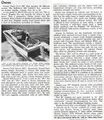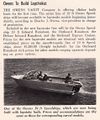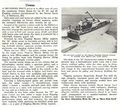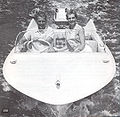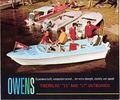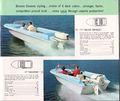Difference between revisions of "Owens"
(added 1957 article) |
(added 1958 photo) |
||
| Line 115: | Line 115: | ||
File:Owensa58006.jpg|1958 Owens "Delivered Freight" Ad, page 2 | File:Owensa58006.jpg|1958 Owens "Delivered Freight" Ad, page 2 | ||
File:Owensa58007.jpg|1958 Owens Flagship Cruisers Article | File:Owensa58007.jpg|1958 Owens Flagship Cruisers Article | ||
| + | File:Owensa58008.jpg|1958 Owens "2500" Express Cruiser | ||
</gallery> | </gallery> | ||
Revision as of 15:41, 25 June 2021
History needed. Please contact us if you would like to edit this page.
Owens Yacht Co.
Stansbury Rd.
Baltimore, Maryland
Cutter Boats, Inc. was a subsidiary of the Owens Yacht Co. Additional history information about both companies is available on the Cutter Boats page. Another subsidiary, Flagship Marine, made inboard marine engines used exclusively in the Owens boats. Owens Flagships were cruiser models; "Speedships" were the smaller, less than 27' models.
The Owens Yacht Co. used Weldwood plywood supplied by the United States Plywood Corporation. Raymond Loewy designed the interior and superstructure of a new 24' model for 1958 (Shipbuilding and Shipping Record).
From the obituary of John B. "Jack Owens", The Baltimore Sun, Feb. 7, 2012:
John B. "Jack" Owens, who had been a principal in the family-owned Owens Yacht Co., the legendary Annapolis boat builder, and later established a real estate firm, died Saturday of heart failure at his Naples, Fla., home.
He was 96.
Mr. Owens was born in Detroit, where his father was a vice president of Westinghouse Electric Corp. and his mother was a homemaker.
After his wife's death in 1918, the elder Mr. Owens moved his children to Spa Creek in Eastport, Annapolis, so relatives could help him raise his daughter and four sons.
He established a custom boat-building business in 1925 on Spa Creek that built about 20 boats a year, and after his death in 1933, the business passed to three of his sons: John B. Owens, Charles Owens Jr. and Norman Owens.
John B. Owens graduated from Annapolis High School in 1933 and earned a pre-law degree from St. John's College four years later.
In 1936, he and his brothers purchased 8 acres on Bear Creek in Dundalk, where they built a state-of-the-art industrial plant.
They adapted the mass-production methods used by the auto industry to boat building.
Mr. Owens was in charge of the company's finances and purchasing while Charles was in charge of advertising and sales and Norman designed the boats.
During its first year in Dundalk, 50 employees built 40 single-design cabin cruisers, and in 1940, 275 workers constructed 150 boats.
Their first major new product was a 32-foot Owens Cruiser that gained the attention of the public and press at the 1937 New York Boat Show.
In a 2007 Style Magazine article, Mary K. Zajac wrote that Owens was known for using top-quality materials in their boats such as "white oak for the stern and framing, copper and brass fastenings, and mahogany imported from the Philippines for planking and finishing work."
With the outbreak of World War II, the company shifted production from pleasure craft to landing craft for the Army when it received a contract to build 2,500 Landing Craft Vehicle Personnel, which Mr. Owens supervised.
He told The Capital in Annapolis in a 1994 interview that he "felt proud his company had played a small part" in the D-Day landings on June 6, 1944, and that the company's workers "realized the importance of doing a good job and as quickly as they could."
After the war, Mr. Owens and his brothers returned to producing the classic 40-foot Owens Cutter, one of the sleekest and fastest sailboats on the Chesapeake Bay and East Coast waters.
They switched from building wooden boats to fiberglass vessels in 1957 and developed a line of Owens Flagship V8 marine engines.
They later expanded to facilities in York, Pa., and a plant in Indianapolis, where they built 800 boats per month, with another 500 constructed in Dundalk.
In 1961, the company was sold to Brunswick Corp., with Mr. Owens staying on as president of Brunswick's Owens Boat Division.
In 1964, Mr. Owens left Brunswick and joined his two brothers in a new business venture, Trident Corp., a family-owned real estate company that managed properties remaining from the sale of Owens Yacht Co.
---
History By Lee Wangstead, Excerpt from "Larson Boat Works/A Short History":
Owens Yacht Company was on a similar mission. Their main interest was in the cruiser market, but had entered the runabout market in the early fifties. In 1957 they built a plant in Tell City, Indiana to produce fiberglass boats. These would be marketed as Cutter Boats, Inc., a division of Owens. They hired three or four key personnel from Lone Star Boats, built a couple of molds splashed from Lone Star models, produced some boats and were promptly sued by Lone Star. There were hundreds of others that were pirating designs from other manufacturers, but none with the financial backing that Owens had. They were an easy target. The court ordered Owens to cease producing these boats and pay a royalty on each one that they had built.
From this harsh lesson, Owens hired noted industrial designer Brooks Stevens to style a new line of boats to carry both the Cutter and Owens nameplates. These designs were mated to an outstanding hull designed by Norman Owens, naval architect and son of Owens founder Charles C. Owens Sr. for introduction in 1958. The first Cutter lineup included three boats: the Jet de Ville, a 15â runabout; the Como, a 15â utility; and the Avon, a 17â deluxe runabout. Cutter advertising proclaimed that they were built in âAmericaâs largest plant devoted exclusively to producing superior fiber-glass boats!â
The dealer network supporting the Owens Yacht Company was based on sales of the large cruisers that they had become famous for. These dealers werenât accustomed to selling boats to the outboard market. Cutter Boats would have to forge their own way into the marine market. But forge they would, based on the strength of their performance and their strong styling they were making inroads into the small runabout market nationwide. In 1959 Owens also introduced a line of larger runabouts designed and built by John Norek in California.
In early 1960 the Brunswick Corporation bought Owens Yacht Company. Brunswick had attempted to buy Chris-Craft but was outmaneuvered by the Shields group. In buying Owens, Brunswick felt that they had a good catch, for considerably less money than the buyout of Chris-Craft would have required. Owens was to concentrate on the cruisers that they were best known for while the runabout market became a secondary issue. John Norek was still turning out a few Owens runabouts from his Crystaliner plant in California.
Brunswick consolidated their holdings into the Brunswick Boat Division. This new division would be broken down into three distinct groups: Owens Yacht Division, featuring the larger cruisers the company had been known for; Larson Boat Division, selling to the middle and upper level trailerable runabout market; and Cutter Boats, building entry level runabouts.
The main focus of the Brunswick Boat Division centered on marketing this new concept to dealers that were interested in heading into the future with a sure winner. So much was at stake and the market had started to soften at this point in time and the dealers came flocking to this new industry âgiantâ.
Brunswick knew that they had to consolidate the plants that they still had. The Larson licensee plants in Ontario, California and Casper, Wyoming had already closed their doors. The Tell City plant was going through some intense labor relationâs issues and the decision was made to move the Cutter/Owens operations to a newly built Larson facility in Alliance, Ohio. Although this plant wasnât operational at the time, the move was made anyway. This left the Little Falls, Minnesota; Nashville, Georgia; and Alliance, Ohio plants to produce enough boats to fill the orders.
After the 1961 season the decision was made by senior Brunswick management to move all operations to a new plant in Warsaw, Indiana. This plant was centrally located and could be efficiently operated, building all three runabout lines: Larson, Cutter, and Owens. The Little Falls plant would be used to assemble the boats after fiberglass production in Warsaw. The Alliance and Nashville plants would be closed. The Alliance plant by this time was operational and producing both Cutter and Owens runabouts successfully. Directions were to take the equipment from both the Little Falls and Alliance plants and move them to Warsaw. This was done over Labor Day weekend in 1961. Brunswickâs idea was to start fresh and eliminate the two factions wrestling for control of the division. They brought in a management team from Chrysler to run this new operation.
In three short selling seasons the Larson name went from the forefront of the industry to entry level production. Carl Kiekhaefer wanted the small boat division gone, and now it was happening, Brunswick was looking to sell the division and try to regroup its Owens cruiser holdings and consolidate the Mercury Marine division.
In late August of 1963 Brunswick tried to shed their small boat division but had no callers. Claiming that the small boat division âdid not fit into the total corporate pattern,â they were willing to listen to any offer. They contacted the former management team in Little Falls and even they had their doubts about resurrecting the sinking ship. Earl Geiger, Sumner Young, and Paul Larson became the major investors who bought the company back on November 8, 1963. A later newspaper account listed the purchase amount at âaround $160,000â. This was little more than the cost of inventory.
For more information, see the Owens Yacht Marque Club
Model Info
1957 Info
1958 Info
1959 Info
1960 Info






